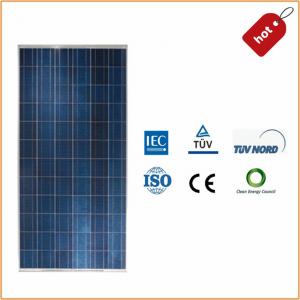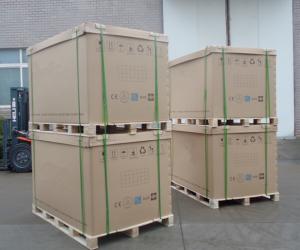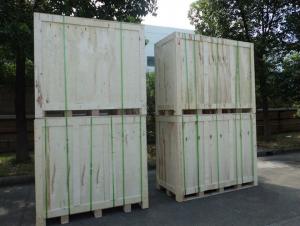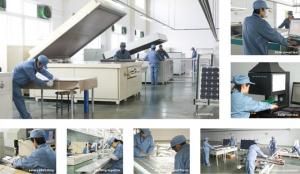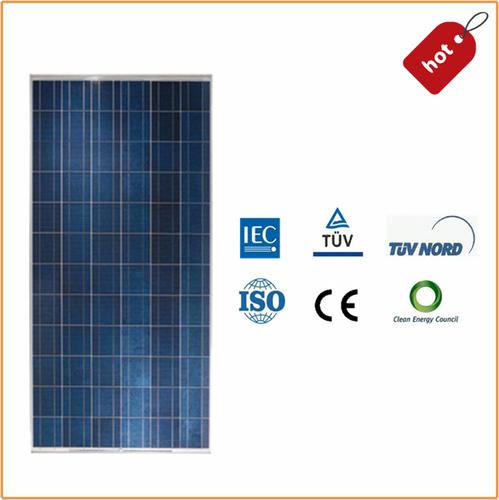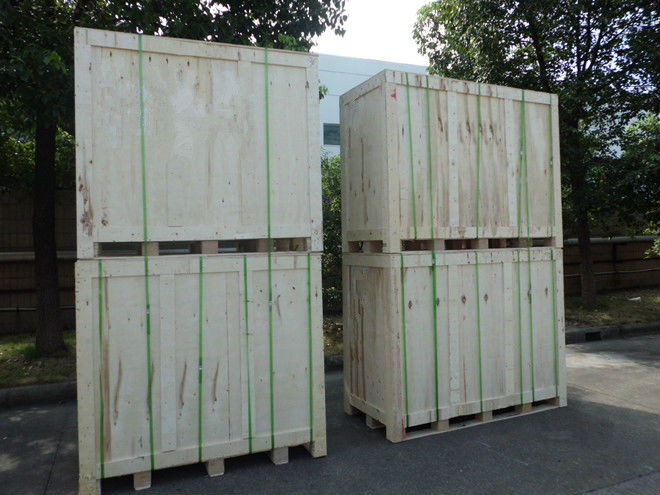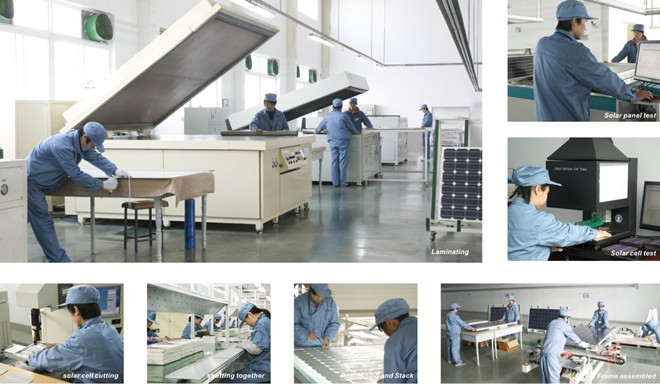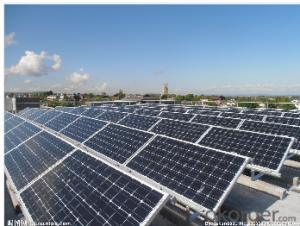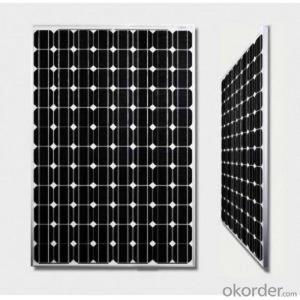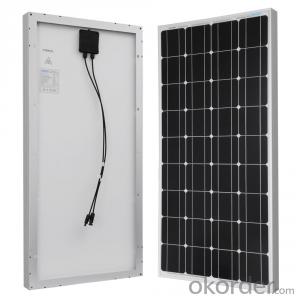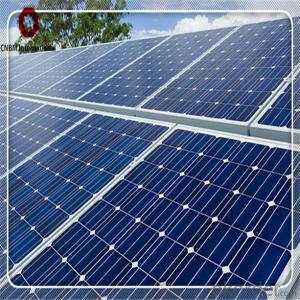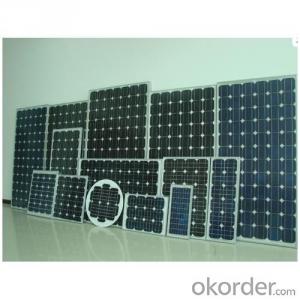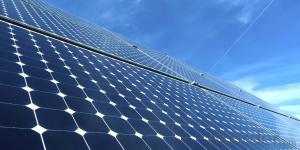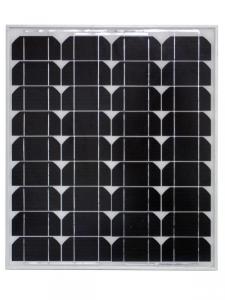Solar Panels Vermont 310W from China Manufacturers
- Loading Port:
- Ningbo
- Payment Terms:
- TT or LC
- Min Order Qty:
- -
- Supply Capability:
- 600MW watt/month
OKorder Service Pledge
OKorder Financial Service
You Might Also Like
Competitive Prices 310w Poly Solar Panels
Solar Panel 300w with Good Quality and Warranty
Mechanical Characteristics
Cell Type | Poly Crystalline 156×156mm(6 inch) |
No. of Cells | 72(6×12) |
Dimension | 1950×992×50mm |
Weight | 23kg |
Component element
Front Glass | 3.2mm, High Transmission, Low Iron, Tempered Glass |
Frame | Anodized Aluminum Alloy Type 6063-T5 |
Junction Box | IP 65 Rated (Black) |
Output Cables | TUV 1×4mm2, length:900mm |
Connector | MC4(UV resistance and self-locking/IP67) |
Encapsulation Material | EVA(0.50±0.03mm thickness) |
Back Foil | White TPT(0.32±0.03mm thickness) |
Fixing Adhesive | Silicone Sealant(White) |
Specifications
Module Type | NBJ-270P | NBJ-280P | NBJ-290P | NBJ-300P |
Maximum Power at STC (Pmax) | 270Wp | 280Wp | 290Wp | 300Wp |
Maximum Power Voltage (Vmp) | 36.21V | 36.38V | 36.50V | 36.60V |
Maximum Power Current (Imp) | 7.46A | 7.61A | 7.95A | 8.20A |
Open-circuit Voltage (Voc) | 43.50V | 43.70V | 43.95V | 44.30V |
Short-circuit Current (Isc) | 7.98A | 8.24A | 8.50A | 8.77A |
Cell Efficiency (%) | 15.7% | 16.3% | 16.9% | 17.2% |
Module Efficiency (%) | 14% | 14.5% | 15.0% | 15.5% |
Operating Temperature( °C ) | -40°C ~+90°C | |||
Maximum System Voltage(V) | DC 1000V(TUV) / DC600V(UL) | |||
Maximum Rated Current Series(A) | 15A | |||
Power Tolerance | 0~+3% | |||
Temperature Coefficients of Pmax | (-0.45±0.05)%/°C | |||
Temperature Coefficients of Voc | (0.05±0.01) %/°C | |||
Temperature Coefficients of Isc | (-0.35±0.02)%/°C | |||
NOTC(°C ) | (47±2)°C | |||
STC: Irradiance 1000W/M2 Module Temperature: 25°C AM=1.5
Warranty
Warranty | 10-year warranty on product material and processing technology |
Industry power output warranty: 90% in 12 years, 80% in 25 years |
Packing Configuration
Q’ty/Pallet, | 1×20’ft | 1×40’GP | 1×40’HQ |
Pallet Q’ty | 5pallets | 11pallets | 11pallets |
Q’ty/Container | 200pcs | 440pcs | 495pcs |
Package

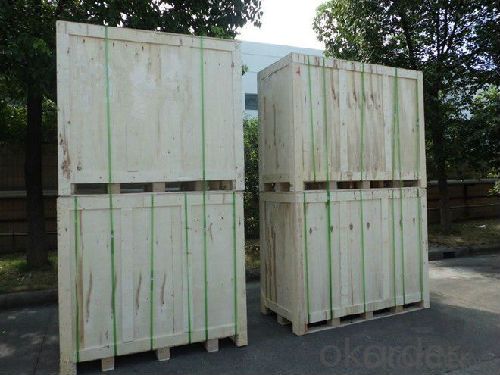
FAQ
I. Will you focus on the safety of the goods during transportation?
Yes, Safety of the cargo is the primary element that we would consider on transportation.
II..How would guarantee the quality will meet the requirements of your clients?
Before shipment, we will have inspection for each batch of goods.
III..What certificates do you have?
IEC,UL,TUV,CSA,etc.
IV..Can you do OEM according to clients’ requirements?
Yes, we have our own brand while we can provide OEM service.
- Q: Can solar panels be installed on a factory or manufacturing plant?
- Yes, solar panels can be installed on a factory or manufacturing plant. In fact, many industrial facilities are increasingly adopting solar power as a sustainable and cost-effective energy solution. Installing solar panels on factory rooftops or open spaces can help offset electricity consumption, reduce carbon emissions, and provide long-term savings on energy bills.
- Q: How long does it take to recoup the investment in solar panels?
- The time it takes to recoup the investment in solar panels varies depending on several factors such as the cost of the panels, installation expenses, local energy rates, and available incentives. On average, it typically takes around 6 to 10 years to recoup the initial investment. However, with decreasing panel costs and increasing energy savings, the payback period is continually improving, making solar panels a worthwhile long-term investment for many homeowners and businesses.
- Q: What materials are solar panels made of?
- Solar panels are typically made of silicon, which is a semiconductor material, along with other components such as metal frames, glass, and protective layers.
- Q: Can solar panels be installed on residential complexes or apartment buildings?
- Yes, solar panels can be installed on residential complexes or apartment buildings. Many residential complexes and apartment buildings have successfully installed solar panels to generate clean and renewable energy for their residents. This not only helps in reducing electricity bills but also contributes to a greener and more sustainable environment.
- Q: I would like to know if I had a mobile kitchen could I power it from solar panels mounted atop the vehicle (truck).(to power electric kitchen equipment, i.e. stove, deep fryer.), instead of propane…could I possibly connect the solar panels to a battery to save my generated electricity? If solar panels would not be enough power could a small windmill suffice…?
- The best way to find out is to determine the wattage of each piece of equipment you want to use and how many hours you want to use those pieces of equipment. Finally, calculate the total number of Watt-Hours you need at minimum. Then you need to research solar panels or mobile wind mills (they need to be pretty huge to get a decent amount of energy I think, so solar power is probably the way to go). You will need to figure out the efficiency of the solar panels, the size of the array, how you will turn it or if you will turn it at all (to face the sun to get the maximum energy input, or maybe to use mirrors so you don't have to turn it. Once you find a good configuration for your mobile kitchen, you need to calculate if the Watt-Hours you will generate on an average day (with average weather) is enough to power the equipment whose energy requirements you previously calculated. Then you have to keep in mind that some days will have no sun, and you may not be working on some days, but you can still capture sunlight. For each case, a large battery array will be required. If you had a guage on that array, you could also hook it up to the a small generator in case you need immediate power. It's an eco-friendly process, but the initial cost is high and it requires a lot of research and planning. This is why most people do not do it--not because they don't want free energy from the sun, but because it's not easy to start collecting that energy in an efficient way. Sorry I couldn't give you more specific numbers, but a solar panel sales agency should be able to estimate whether or not you could do it (they'd probably set it all up for you too). ^_^
- Q: looking for a solar panel to charge my laptop on the road, macbook is 60 watt 6.v 3.5a, what should i be looking for in a solar panel?
- Well that's a good idea,,,here's what ya need..First you need an array that will overcome the drain effect created by the in use or sleeping laptop...that is best solved by averaging out the real use of the machine in terms of watt/minutes...If you check your transformer you'll see it has a capacity which you have cited however the true use of the computer is about 40-50 percent of that in watt/minutes..but only while your using it and when in the sleep mode the watt/minute value drops even more to about 5%.... So if your actual use consists of 2 hours of use per day at 50% and 2 hours at 5% percent the actual wattage draw is only averaged out at 34watts/minute. optimally your panel should supply all your power from its photovoltaic conversion ,but in the real world application the panel only recharges ,over a period of time, the used power. So if you had a 5 watt (@ 2vdc) panel working 480 minutes and used up 35 x2=700 and 9 x2=8 for a total of 78 watts you would have 5 x 480 = 7200 watts input and a parasitic load of 78 watts in the two hours...well within the recharge state required.. For a little safety I would permanently wire a cigarette lighter type plug to the end of the panel this will keep the polarity correct and serve as a quick disconnet means...Also add a fuse at .5 amp... a good place to get these are on the internet....some are very expensive some a very cheap --go for a middle of the roader...Have a good one from the E...
- Q: I would like to know how do you build a solar panel?
- i think the evil Genius book has how to build home made solar cells.
- Q: I am told there are night vision goggles to see at night due to invisible light still hitting earth. I am also told that there are other beams, x-rays etc hitting earth.Why couldn't they invent a solar panel with dual power in the day?It could harness both visible and invisible light, and at night be single?Anyone know why they can't make an invisible light solar panel?Is this possible?What happens if future cars have night vision windshields instead of lights?
- They are actually working on building photovoltaic panels (Photovoltaic is actually the correct term for sunlight--electricity. Ordinary solar panels are those that use sunlight to heat water) that harness a larger range of wavelengths. From what I can gather the problem is either finding a material that absorbs more wavelengths, or finding a way to get multiple materials to coexist in a single panel. This situation will no doubt improve over time as new things like Nanotechnology give us the ability to create much more complex substances designed at the molecular level for light capture. Panels that can harness a wider range of the spectrum do exist, but the technology is in its infancy, and therefore expensive and not widely known. This isn't too surprising when you consider that Photovoltaic technology itself hasn't been in the mainstream all that long. I am a bit doubtful of photovoltaics that work at night, for the simple reason that at night there is less of *every* kind of energy falling on earth. Less visible light, infrared, etc. Infrared just happens to be particularly good at giving away hot objects, which is how Night Vision goggles work. For the same reason, a night vision windshield might be a very useful tool, but it would still have difficulty picking out colder objects, and those that reflected less infrared light. In other words, you might see cars and pedestrians, but you could easily miss the upcoming embankment 0.o .
- Q: I mean when light hits the solar panel where does the energy go and what does it become? Be specific.
- Visible light from the sun is in the form of photon before hitting the solar panel. In a silicon solar panel, the photon is caught by the semiconductor material. Energy equivalent of the photon is then used to excite an electron from the semiconductor molecule. The aggregate of free flowing electrons form the current in a closed electric circuit. The efficency of conversion from sun light to electricity is not 00%. The majority of light energy hitting the solar panel is dissipated in the form of heat. As technology advances, the conversion efficiency is improving, hence reducing the cost of solar energy.
- Q: Can solar panels be installed on a school or university campus?
- Yes, solar panels can be installed on a school or university campus. Many educational institutions are embracing solar energy as a sustainable and cost-effective solution for their energy needs. Installing solar panels on campus can help reduce electricity costs, lower carbon emissions, and provide educational opportunities for students to learn about renewable energy. Additionally, schools and universities can take advantage of various incentives and grants available for renewable energy projects, making solar panel installation an attractive option.
Send your message to us
Solar Panels Vermont 310W from China Manufacturers
- Loading Port:
- Ningbo
- Payment Terms:
- TT or LC
- Min Order Qty:
- -
- Supply Capability:
- 600MW watt/month
OKorder Service Pledge
OKorder Financial Service
Similar products
Hot products
Hot Searches
Related keywords
